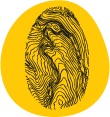
LOCUS – a model for optimisation of spatial structure of habitats
The spatial characteristics of habitats (e.g. patch size, shape complexity and connectivity between habitats) affect conditions for biological diversity (Olff & Ritchie 2002; Tews et al. 2004). The Danish rural landscape is dominated by intensively-managed cropland. Natural and semi-natural habitats are generally small, have complex shapes and are spatially isolated (Levin 2007). Extensive land use (e.g. permanent grassland and set-aside land) can, if the placement in the landscape is based on relevant spatial criteria, improve spatial structure of habitats and thus benefit conditions for biological diversity (Herkert 2009; Stadler et al. 2007).
This paper presents results from the LOCUS project (Levin 2013). One aim of LOCUS is to develop a model for optimised allocation of agricultural land use on basis of pre-defined spatial criteria. The spatial criteria considered are increase of patch size, reduction of shape complexity (ratio between habitat size and edge length) and improvement of connectivity (number of connected habitat patches). The model is based on a national land raster map (Levin et al. 2012) with a resolution of 10x10 metres, containing information on agricultural management and habitat types. The model is applied to examine the outcomes of a possible reform of the common agricultural policy (CAP), introducing a mandatory requirement to put 5 % of farmland into extensive land use (Hart & Baldock 2011). Two alternative scenarios of CAP-reform are tested for the Danish island Zealand. In the first scenario, it is assumed that the 5 % requirement applies for individual farm units. (I.e. on each of the approximately 8,000 farm units on Zealand, 5 % of the intensively managed land (cropland) is put into extensive land use.) For the second scenario, it is assumed that 5 % of all cropland on Zealand is put into extensive land use, regardless of which farms manage the land. In both scenarios almost 20,000 hectares of cropland are converted into extensive land use, almost doubling the total area of extensive agricultural land use on Zealand.
Results show that, when spatial criteria for allocation of extensive land use are taken into account, the spatial structure of habitats is improved. Comparing the outcome of the two scenarios, it is evident that improvement of habitat structure is less pronounced when the 5 % requirement is applied at the farm scale. This is particularly the case for improvement of habitat connectivity, but also for patch complexity. These results are in line with other studies (e.g. Levin & Jepsen 2010; Tscharntke et al. 2005), indicating that regulations for improvement of habitat structure are more successful when applied at a cross-farm scale. The paper concludes that the LOCUS model can form a useful instrument to guide farmers and stakeholders in land-use planning. However, for specific local plans, in situ information on biological and physical characteristics, which are not addressed in the model, should be taken into consideration.
Hart; K. & Baldock, D (2011) Greening the CAP: Delivering environmental Outcomes through pillar one. Institute for European Environmental Policy. http://www.ieep.org.uk/assets/831/Greening_Pillar_1_IEEP_Thinkpiece_-_Final.pdf
Herkert, J. (2009) Response of bird populations to farmland set-aside programs. Conserv. Biol.23,1036–1040.
Levin, G. (2007) Relationships between Danish organic farming and landscape composition. Agric.Ecosyst.Environ.120, 330–344.
Levin, G. & Jepsen, M. R. (2010) Abolition of set-aside schemes, associated impacts on habitat structure and modelling of potential effects of cross-farm regulation. Ecol. Mod. 221:22, 2728-2737 begin_of_the_skype_highlighting 2728-2737 end_of_the_skype_highlighting begin_of_the_skype_highlighting 2728-2737 end_of_the_skype_highlighting.
Levin, G., Jepsen, M. R. & Blemmer, M. K. (2012) Basemap: Technical documentation of a model for elaboration of a land-use and land-cover map for Denmark. Aarhus University, DCE – Danish Centre for Environment and Energy, 47 pp. (Technical Report from DCE - Danish Centre for Environment and Energy, No. 11). http://www2.dmu.dk/pub/tr11.pdf
Levin, 2013. Modelling allocation of agricultural land use to improve biodiversity (LOCUS). Project website http://www.dmu.dk/en/society/agriculture/locus/
Olff, H. & Ritchie,M.E.(2002) Fragmented nature: consequences for biodiversity. Landscape UrbanPlan. 58, 83–92.
Stadler, J., Trefflich, A., Brandl, R. & Klotz, S. (2007) Spontaneous regeneration of dry grasslands on set-aside land. Biodivers. Conserv. 16, 621–630.
Tews, J., Brose, U., Grimm, V., Tielbörger, K., Wichmann, M. C., Schwager, M. & Jeltsch, F. (2004) Animal species diversity driven by habitat heterogeneity / diversity: the importance of keystone structures. J. Biogeogr. 31, 79–92.
Tscharntke, T., Klein, A. M., Kruess, A., Steffan-Dewenter, I. & Thies, C. (2005) Landscape perspectives on agricultural intensification and biodiversity – ecosystem service management. Ecol. Lett. 8, 857–874.
